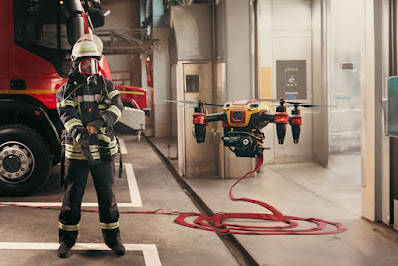Introduction:
Fire extinguishers are the unsung heroes of fire safety, providing a quick and effective means to control small fires before they escalate. However, their reliability hinges on regular inspections and maintenance. In this comprehensive guide, we'll explore the importance of local fire extinguisher inspections near me, the types of extinguishers available, and the steps you can take to ensure these life-saving devices are always ready to perform when needed.
Understanding the Importance of Fire Extinguisher Inspections
1.1 First Line of Defense
Fire extinguishers serve as the first line of defense against small fires, providing immediate action to prevent them from spreading. Regular inspections ensure that extinguishers are functional and ready for use when the need arises.
1.2 Legal Compliance
In many regions, there are strict regulations governing the installation and maintenance of fire extinguishers. Compliance with these regulations is not just a legal requirement but also a critical aspect of ensuring the safety of occupants in a given space.
1.3 Prolonging Lifespan
Routine inspections not only identify potential issues but also contribute to the longevity of fire extinguishers. Regular checks help prevent deterioration and ensure that extinguishers remain in optimal condition, ready to tackle emergencies effectively.
Types of Fire Extinguishers
Before delving into the inspection process, it's important to understand the different types of fire extinguishers and their designated uses.
2.1 Water Fire Extinguishers (Class A)
Water extinguishers are suitable for fires involving ordinary combustible materials such as wood, paper, and textiles. They work by cooling the fire and removing the heat element.
2.2 Foam Fire Extinguishers (Class A and B)
Foam extinguishers are effective against fires fueled by flammable liquids (Class B) and ordinary combustibles (Class A). The foam forms a blanket over the fire, smothering it and preventing re-ignition.
2.3 Dry Powder Fire Extinguishers (Class A, B, and C)
Dry powder extinguishers are versatile, capable of suppressing fires involving flammable solids (Class A), flammable liquids (Class B), and flammable gases (Class C). The powder disrupts the combustion process.
2.4 CO2 Fire Extinguishers (Class B and C)
Carbon dioxide (CO2) extinguishers are designed for electrical fires (Class C) and flammable liquid fires (Class B). CO2 displaces oxygen, suffocating the fire.
2.5 Wet Chemical Fire Extinguishers (Class K)
Wet chemical extinguishers are specifically designed for kitchen fires involving cooking oils and fats (Class K). The chemical reacts with the cooking oil to create a soap-like substance, preventing re-ignition.
Fire Extinguisher Inspection Guidelines
Now that we've covered the importance of inspections and the types of fire extinguishers, let's delve into the step-by-step process of conducting a thorough inspection.
3.1 Visual Inspection
Begin with a visual inspection of the fire extinguisher. Check for any obvious signs of damage, such as dents, rust, or corrosion. Ensure that the pressure gauge or indicator is in the operable range.
3.2 Accessibility
Verify that the fire extinguisher is easily accessible and not obstructed by objects or stored items. In an emergency, quick access to the extinguisher is paramount.
3.3 Pressure Check
For pressurized extinguishers, confirm that the pressure gauge or indicator is within the recommended range. If the gauge is in the red zone or indicates low pressure, the extinguisher may need recharging or replacement.
3.4 Inspection Tag
Examine the inspection tag to ensure that the extinguisher has undergone regular inspections as per local regulations. This tag provides a quick reference for the last inspection date and any necessary maintenance.
3.5 Physical Condition
Inspect the hose, nozzle, and handle for any damage or signs of wear. Check that the safety pin is intact and the tamper seal is unbroken. If there are any issues, the extinguisher may need professional servicing.
3.6 Extinguishing Agent
Ensure that the extinguishing agent inside the cylinder is not clumped or settled. Some extinguishers may require periodic shaking to prevent the powder or chemical from compacting.
Professional Inspection and Maintenance
While regular visual inspections are essential, a professional inspection by a certified technician is equally important. Professional inspections typically include more in-depth examinations and maintenance procedures.
4.1 Annual Inspections
Most regions mandate an annual inspection by a qualified technician. This inspection involves a thorough examination of the extinguisher's internal components, ensuring that all parts are in working order.
4.2 Hydrostatic Testing
Depending on the type of extinguisher, it may require hydrostatic testing at specific intervals. This testing assesses the integrity of the cylinder and ensures it can withstand the pressure required for effective fire suppression.
4.3 Recharging
If the extinguisher has been used or if the pressure is below the recommended level, it may require recharging. Professional technicians have the expertise and equipment to safely recharge extinguishers with the appropriate extinguishing agent.
4.4 Record-Keeping
Maintain detailed records of all inspections and maintenance activities. This documentation serves as proof of compliance with local regulations and provides a historical record of the extinguisher's maintenance history.
User Training and Emergency Preparedness
In addition to regular inspections and professional maintenance, user training and emergency preparedness are crucial aspects of fire safety.
5.1 User Training
Educate occupants on the basics of fire extinguisher usage. Provide training on how to operate the extinguisher, the appropriate type for different fire classes, and the importance of immediate reporting after use.
5.2 Emergency Response Plans
Integrate fire extinguisher use into broader emergency response plans. Ensure that occupants know the evacuation routes, assembly points, and emergency contacts. Regular fire drills contribute to increased awareness and preparedness.
Conclusion:
Regular fire extinguisher inspections are the linchpin of effective fire safety. By understanding the importance of inspections, familiarizing yourself with the types of fire extinguishers, and following the guidelines for visual checks, you contribute to creating a safer environment for yourself and those around you. Professional inspections and user training complete the circle of fire safety, ensuring that these vital devices remain ready to extinguish doubt and protect lives. Stay vigilant, stay informed, and together, let's ensure that our spaces are equipped for swift and effective fire response.

Comments
Post a Comment